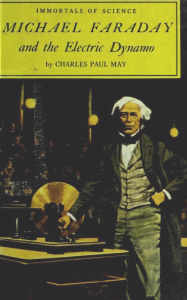Michael Faraday and the Electric Dynamo

Author:
Charles Paul May
Illustrator:
Geoffrey Biggs
Publication:
1961 by Franklin Watts, Inc
Genre:
Biography, Non-fiction, Science
Series:
Immortals of Science ![]() Members Only (World History)
Members Only (World History)
Pages:
144
Current state:
This book has been evaluated and information added. It has been read but content considerations may not be complete.
Book Guide
Search for this book used on:
Michael Faraday was a blacksmith's son who became one of the world's most honored scientists.
Apprenticed to a London bookbinder, Faraday received his start in science by presenting a well-bound book of Humphry Davy's lecture notes to Davy himself. Faraday also asked the famous scientist for an assistant's job—and got it.
That was only the beginning. Faraday went on to surpass Sir Humphry himself in scientific achievements. One question, however, had always bothered Faraday. He knew that a current-carrying wire set up a magnetic field around itself. Could that same magnetic field somehow produce an electric current?
When Faraday discovered that it could, the electric dynamo was born and widespread electrical power eventually became possible.
From the dust jacket
To view an example page please sign in.
Content Guide
Please sign in to access all of the topics associated with this book and view other books with the same topics.
Please sign in to access the locations this book takes place in and view other books in the same location.
Please sign in to access the time periods this book takes place in and view other books in the same time period.
For information about the lead characters please sign in.
Reviews

The Immortals of Science Series
Reviewed by Sara Masarik
These books are of varying lengths based on how much is known about the lives of the subject. Whatever the length, I sped through each one as though it were a suspense novel. How will this one manage to carry on his work in the midst of civil war? How can that one earn the respect of the scientific community so his work can be published for the world? What will be the exciting sequence of events that will lead to the ultimate breakthrough? Will he live long enough to find the answer he has searched for all his life?
The science in these books is written in language any curious reader will be able to understand. The authors don’t condescend, but the writing is not above a confident reader, perhaps ten and above. They would also be interesting enough for reading aloud so they can be shared with the entire family, whatever their ages.
Find This Book
Search for this book used on:



